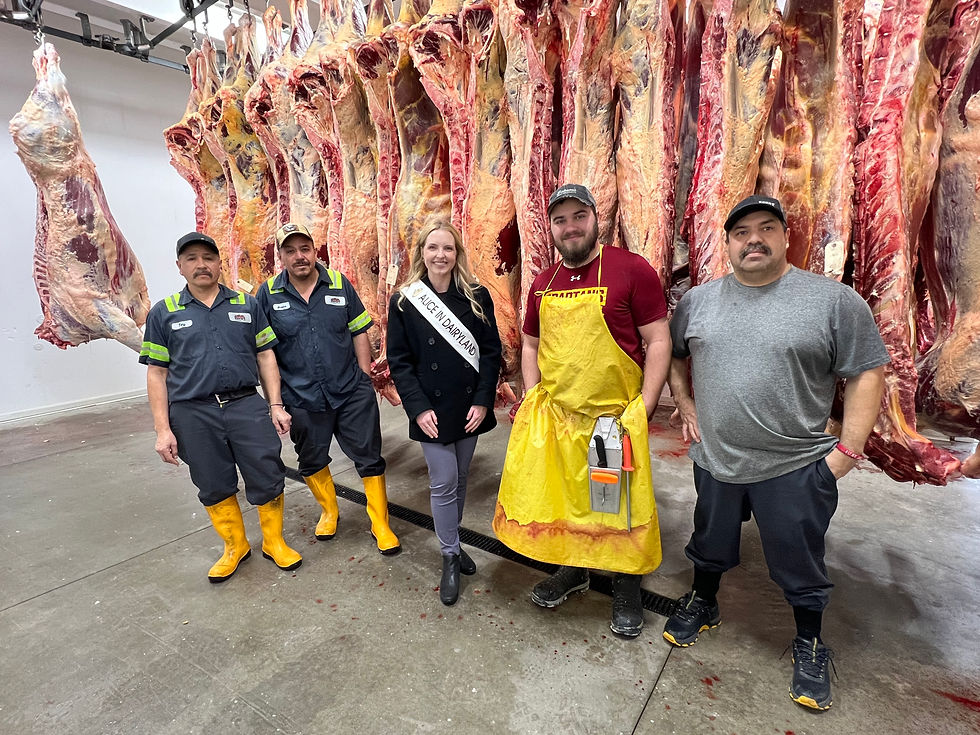Beef producers focus on sustainability
- Alice in Dairyland
- May 5, 2024
- 2 min read
Sunny May days are made for grilling out, but the cherry (tomato) on top is that May is also Beef Month! We have a lot to celebrate in Wisconsin, with more than 27,000 farms and ranches with cattle that contribute to providing wholesome culinary options.
Beef can be a nutrient dense part of a balanced diet. In just one 3 oz. cooked serving, you’re getting 10 essential nutrients, including protein, zinc, iron, and B vitamins. The nutrients found in beef provide our bodies with what we need to grow and thrive throughout all of life’s stages.
Wisconsin’s beef farmers are focusing on sustainably producing a product that is healthy for the eater but also the environment it’s raised in. The Wisconsin Beef Council shares its three pillars of sustainability: social responsibility, economic viability, and environmental stewardship. Social sustainability is based on your community and organizational resilience. This could include “worker safety, animal welfare, antibiotic and technology use, and the culture and traditions of beef producers.”
Practices that encourage economic success without harming the social and environmental aspects of a community fall into the economic pillar. Tactics could include “improving rural economies and livelihoods, affordability of beef to consumers, profitability of beef producers, and the value of ecosystem services.”
The third pillar, environmental stewardship, involves preserving and improving our natural resources, the ecosystem’s services, and ecological health. This specifically looks at “biodiversity, carbon and water footprints, wildlife habitat, soil and rangeland health, and the ability of cattle to utilize human inedible feeds, among others.”
Part of raising cattle sustainably is reducing the amount of waste created. The cattle themselves start this process by eating the plant materials left over from food for humans, like corn stalks, brewers’ grains, pea pulp, beet tops, or potato peelings, and turning that into beef. Utilizing the by-products that come from cattle also helps reduce waste that would otherwise be created by the industry. In fact, about 99% of your typical beef animal can be used in some way. Shoes, Band-Aids, conditioner, instrument strings, crayons, makeup, plant food, and more are all items we wouldn’t have without beef by-products.
As Alice in Dairyland, I have greatly enjoyed working with the Wisconsin Beef Council to share recipes that use Wisconsin beef products, beef nutrition facts, and how Wisconsin beef is produced from the farm to our tables. The by-products that we receive from beef cattle are a valuable part of our everyday lives, and one of the main goals of Wisconsin’s beef producers is to sustainably raise their cattle while ensuring the success of future generations to come. Growing up in the agriculture industry, high-quality beef was a part of many meals on our kitchen table, and I enjoy continuing to learn about the many ways we can enjoy and use beef as part of a sustainable and well-balanced lifestyle.
If you want to learn more about your local beef farmers, how beef fits into a healthy and sustainable life, selecting the best cut of meat for the occasion, or recipe ideas, the Wisconsin Beef Council has excellent resources and tips for all of the above at beeftips.com. Before firing up the grill for Beef Month, take the chance to “beef up” your knowledge!





























